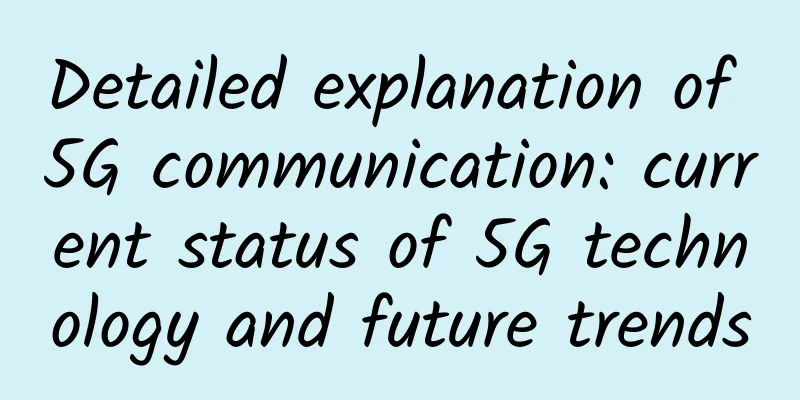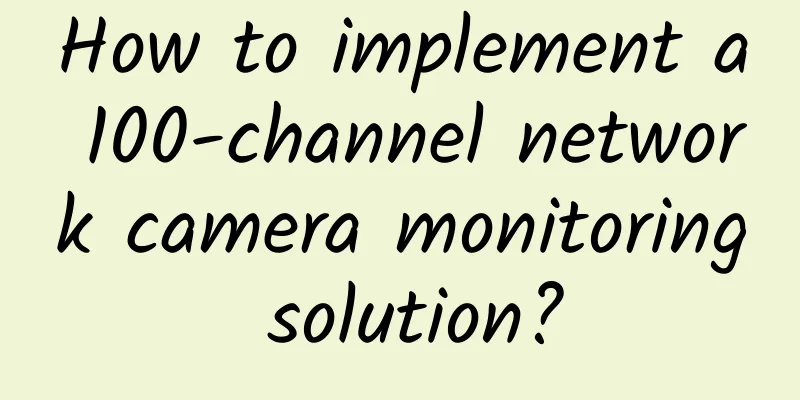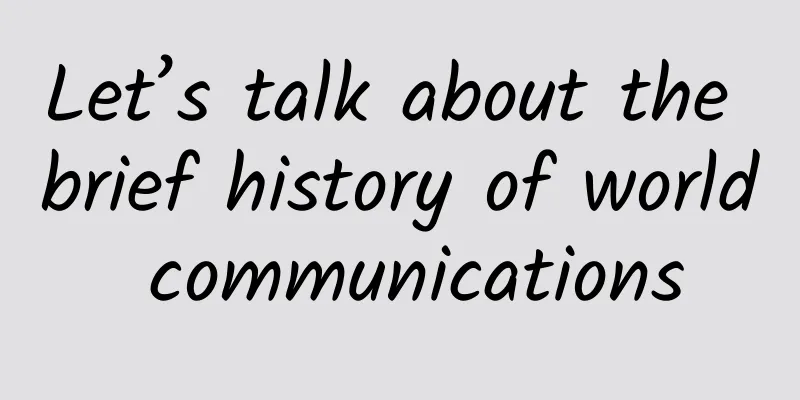Detailed explanation of 5G communication: current status of 5G technology and future trends

|
Since 2016, 5G has become increasingly popular. As the next generation of mobile communication network, if there is one keyword to describe 5G, it is "fast". 5G will not only greatly change people’s existing way of life and work and improve communication efficiency, but also increase the possibility of the implementation of many cutting-edge technologies and products. 5G affects the nerves of many companies and is enough to change the landscape of the mobile communications industry and even involve national interests. We have seen that both foreign companies such as Qualcomm and Intel, as well as domestic enterprises such as Huawei, ZTE and Lenovo, and major telecom operators are actively deploying 5G, striving to seize the initiative in the 5G landscape and gain maximum benefits. The author attempts to explain 5G from different perspectives, including the evolution of mobile communication networks, 5G technology, and the formulation of 5G international standards, so that you can have a better understanding of it. From mobile phones to smartphones In 1983, Motorola's first commercial mobile phone was launched on the market. It cost $3,995 and weighed 1.13 kilograms, comparable to a "brick". Chinese people used the term "big brother" to describe this expensive and bulky mobile phone. At that time, big brothers were regarded as a symbol of wealth and status, and were something that many people dreamed of. Two people can make calls with a mobile phone. The technology behind it is the first generation of cellular mobile communication system (1G). 1G is analog cellular mobile communication, but because it is analog communication, it has poor anti-interference ability. At the same time, the simple FDMA technology makes the frequency reuse and system capacity low. Later, mobile phones became smaller and smaller, and their performance gradually improved. Nokia and Motorola mobile phone brands began to gain popularity: this was the 2G era. Unlike 1G, 2G is digital communication, and its anti-interference ability has been greatly improved. At the same time, 2G can be said to have laid the foundation for the subsequent 3G, such as the introduction of packets and the compatibility transformation of the air interface, so that mobile phones no longer have only single functions such as voice and text messages, but can also access the Internet more efficiently. If 2G was just a "fresh taste" for everyone, then 3G networks have brought real changes. 3G networks can process multiple media forms such as images, music, and video streams, and provide a variety of information services including web browsing, teleconferencing, and e-commerce. However, 3G was too slow and not suitable for watching videos or playing games, so 4G came into our view and smartphones emerged. If 3G allowed people to enter the Internet, then 4G stimulated the prosperity of Internet applications, with instant messaging, online shopping, online payment, online video, online games and other applications emerging in an endless stream. However, the emergence of new scenarios and application requirements such as the Internet of Things, real-time playback of 4K and 8K videos, autonomous driving, telemedicine, etc., has made 4G "unable to cope", so people have begun to study 5G, also known as the fifth-generation mobile communication system. 5G Compared with 4G, 5G network speed can reach 15Gb per second. This means that high-definition movies can be downloaded in seconds, online games, real-time high-definition video and remote interaction are no longer a dream. At the same time, 5G networks have three characteristics: extremely high speed (eMBB), extremely large capacity (mMTC) and extremely low latency (URLLC), such as 10Gbps peak data rate, 1ms air interface transmission latency, 3-5 times higher spectrum efficiency than 4G, 1G connection density per square kilometer, and 100 times higher power efficiency. It is conceivable that by 2020, 5G will provide users with fiber-like access speeds, "zero" latency experience, connectivity for hundreds of billions of devices, ultra-high traffic density, ultra-high connection density, ultra-high mobility and other consistent services in multiple scenarios, realizing the vision of "information at your fingertips, everything at your fingertips". Two major international organizations promoting 5G standards Since 5G is so important, many countries and major technology companies are seizing the opportunity, occupying the commanding heights, and striving to become 5G leaders. Unlike before, international organizations have actively promoted the formulation of relevant standards from the beginning, refined the 5G process, and strived to achieve standardization and globalization. Specifically, the organizations responsible for 5G standardization are mainly the International Telecommunication Union (ITU) and the Third Generation Partnership Project (3GPP), which have different focuses and jointly promote 5G. ITU: In June 2015, the organization completed the research on 5G vision; in June 2017, it completed the formulation of minimum technical indicators for IMT-2020 (5G), determined the detailed definitions and applicable scenarios of 14 performance indicators, and completed a series of key documents to support the submission of IMT-2020 candidate technologies and technical evaluation. 3GPP: It is the world's most influential communications standardization organization, mainly coordinating various organizations to form standards in the communications field. It is reported that 3GPP has made it clear that 5G will include two versions, Release 15 (R 15) will be completed in June 2018, and Release 16 (R16) will be completed in September 2019. R15 is divided into two sub-phases. The first sub-phase is to complete the 5G standard of non-standalone networking (NSA) in December 2017; the second sub-phase is to complete the 5G standard of standalone networking (SA) in June 2018. It can be seen that the 5G standard is a very large and complicated project. The conflict of interests in voting freedom In the process of formulating 5G standards, conflicts of interest and competition have been constantly staged between companies, industries and countries. Recently, there have been comments on the Internet that "Lenovo did not vote for Huawei on the 5G solution, but voted for Qualcomm", which has put this highly-watched technology company at the forefront of the storm. We can learn the details of 3GPP's voting on 5G standards through its official website. Since 3GPP is an open international organization, the records of the three meetings are available in the corresponding documents. According to Sanlian Life Weekly, at the first meeting in August 2016, three coding schemes, LDPC, Polar and Turbo, were formally proposed. Qualcomm holds 70% of the patents for LDPC, and Huawei holds the majority for Polar. The focus of the three meetings was on "data channel coding" and "control channel coding". Among them, Turbo coding basically cannot meet the stringent requirements of 5G for the network. LDPC has outstanding advantages in the "data channel", and Polar also has obvious advantages in the "control channel". Lenovo did not appear in the first meeting vote. In the second meeting, Lenovo supported the LDPC solution led by Qualcomm. The final result was that 15 companies supported the LDPC solution, only Huawei supported the Polar solution, 5 companies supported Turbo+LDPC (mostly Japanese and Korean companies), and 17 companies supported LDPC+Polar (mostly Chinese companies). However, the second meeting did not make a final decision. At the third meeting, 33 companies including Qualcomm, Samsung, and Nokia supported LDPC, while 57 Chinese companies including Huawei, ZTE, Xiaomi, and Lenovo supported Polar. Although the number of votes supporting Huawei Polar is large, the voting rights are not enough. For example, Lenovo and Motorola's voting rights may be less than one-third of Nokia's. Due to the low voting rights, the LDPC solution finally got the entire share of 5G mobile broadband data channels. In terms of control channels, Huawei's Polar solution won with an absolute advantage! Postscript: As the next generation of communication technology, 5G has far-reaching impact and great significance. For consumers, it may mean more convenient life and work; for enterprises in the 5G industry chain, it means new opportunities and new markets. Therefore, whether it is a company or a country, they will do everything they can to gain maximum benefits in this 5G battle. |
>>: Three major 5G concepts and four key technologies
Recommend
SaltyfishTech Germany 9929 package free upgrade, 15% off for quarterly payment, $19/quarter-dual core/1GB/15GB/1.15TB@300Mbps
SaltyfishTech (咸鱼云) recently upgraded the Frankfu...
Let’s talk about the technological advances needed to realize the 6G vision
The next generation of cellular technology will b...
Detailed explanation of SSL protocol communication process and symmetric encryption and asymmetric encryption in HTTPS
[[276508]] Symmetric encryption The so-called sym...
Using edge computing to transform networks in a 5G world
As global networks continue to evolve and become ...
Ovum Observation: SDN/NFV Significantly Reduces Time to Market for Services of Operators in Emerging Markets
Early morning news on January 11, for communicati...
Number One "Thousand Faces" - What you see may not be me
[[423706]] Do you have such troubles? It's in...
Sharktech: Los Angeles high-defense server 1Gbps unlimited traffic starting at $129/month, optional 10Gbps unlimited traffic
Sharktech is a long-established foreign hosting c...
The emergence of Wi-Fi HaLow promotes IoT applications and innovation
Few emerging technologies have the transformative...
Explore how Gateway API works in Service Mesh
A few days ago, Gateway API announced that it wou...
Industrial Internet + 5G, we must plan carefully before taking action
In the previous article, "IoT operating syst...
Network cabling management issues in data center transformation and upgrading
Cabling is an important part of the internal netw...
What is Wi-Fi-6E and how is it different from Wi-Fi-6
Three years ago, Wi-Fi 6 technology entered the m...
The latest report of "5G Snapshot: China": Understand China's 5G development layout in one article
[[328614]] The global economy has been put on hol...
Under the SDN wave, where will traditional routing technology go?
introduction "All martial arts come from Sha...
Mobile Edge Computing: The True Future of 5G
The promise of 5G has yet to be fulfilled, but it...








![[Black Friday] Sharktech High-Defense VPS 50% off, $47.7/year-2GB/40GB/4TB/Los Angeles and other data centers](/upload/images/67cac00f76a6f.webp)
